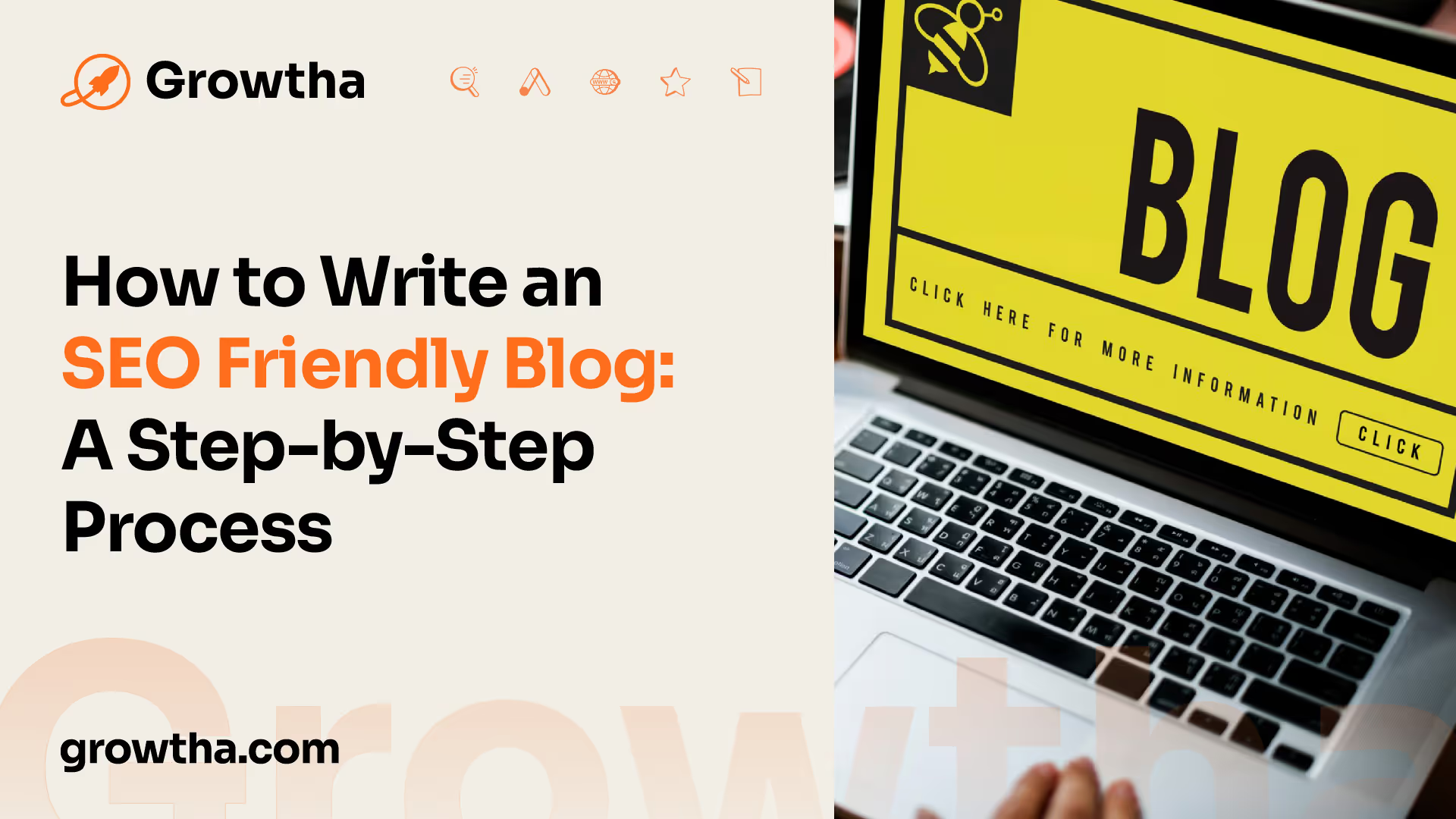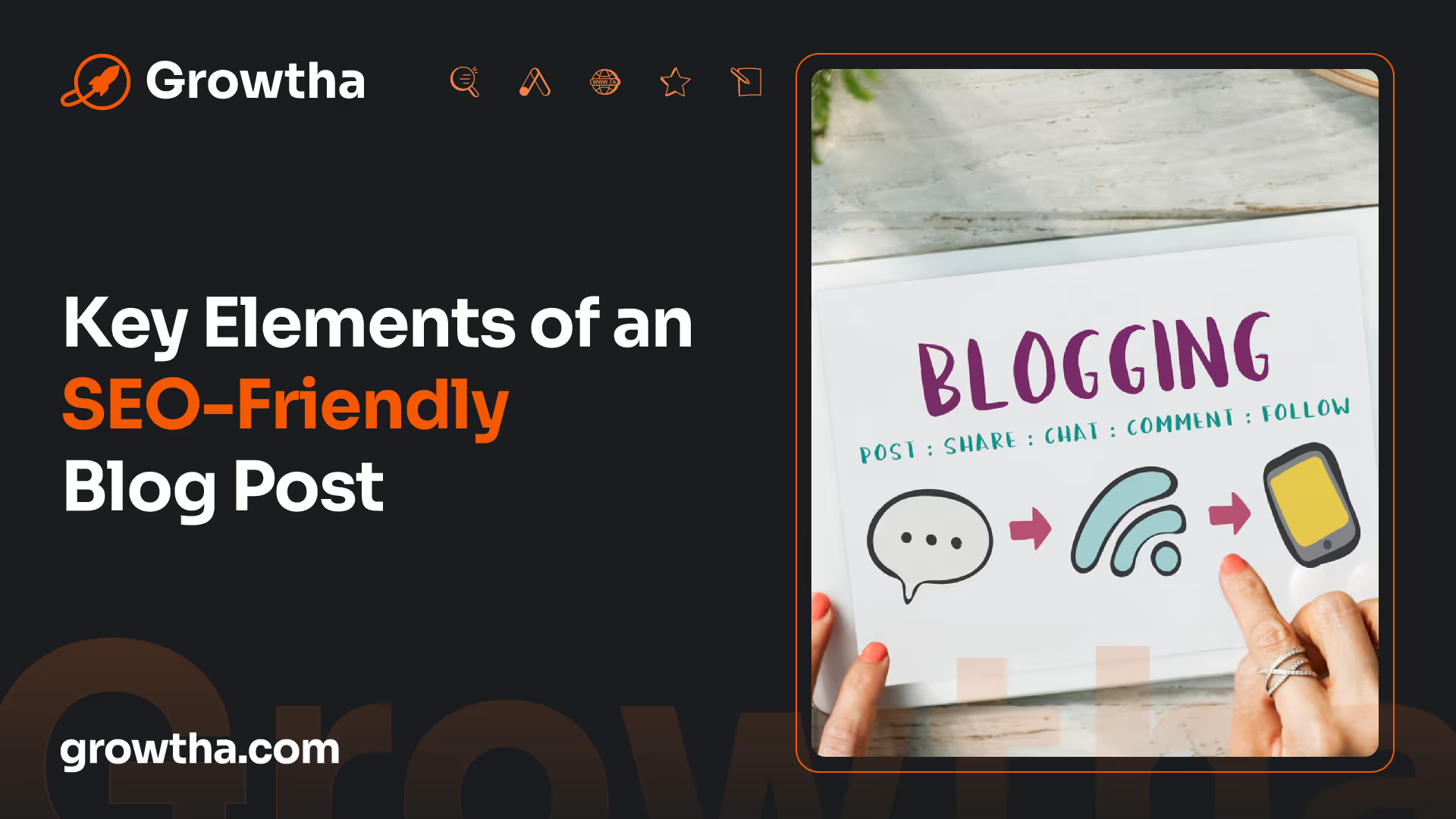How to Write an SEO Friendly Blog: A Step-by-Step Process
This section will explore the importance of SEO in blog writing and highlight key elements of an SEO-friendly blog post.


How to Write an SEO Friendly Blog: A Step-by-Step Process
Understanding SEO-Friendly Blog Writing
To create blog content that is optimized for search engines and attracts organic traffic, understanding the fundamentals of SEO-friendly blog writing is essential. This section will explore the importance of SEO in blog writing and highlight key elements of an SEO-friendly blog post.
Importance of SEO in Blog Writing
Search engine optimization (SEO) plays a vital role in blog writing by improving visibility and driving organic traffic to your content. When you optimize your blog posts for SEO, you increase the chances of your content ranking higher in search engine results pages (SERPs), making it more likely to be discovered by your target audience.
By incorporating relevant keywords, optimizing meta descriptions, and following other SEO best practices, you enhance the visibility of your blog posts to search engines like Google. This, in turn, can lead to increased website traffic, improved brand awareness, and higher engagement with your content.

Key Elements of an SEO-Friendly Blog Post
Several key elements contribute to making a blog post SEO-friendly. By paying attention to these elements, you can enhance the visibility and search engine rankings of your blog content. Some of the key elements include:
- Keyword Research: Conducting thorough keyword research helps you identify relevant keywords and phrases that your target audience is searching for. This forms the foundation of your SEO strategy and guides the optimization of your blog content.
- Catchy Headline: Crafting a catchy headline is crucial to grab the attention of both readers and search engines. It should incorporate the main keyword and be compelling enough to entice users to click and read the full post.
- Engaging Introduction: The introduction serves as a hook to captivate readers and entice them to continue reading. It should address the pain points of your target audience and introduce the main keyword naturally.
- Structured Content: Structuring your blog post with headers and subheaders helps both readers and search engines understand the organization and flow of your content. Breaking down the content into digestible sections improves readability and SEO.
- Valuable Body Content: Delivering high-quality and informative content is key to engaging readers and satisfying search engine algorithms. Incorporate multimedia elements, such as images and videos, to enhance user experience and increase engagement.
- Internal and External Links: Internal and external links play a crucial role in making your blog posts more authoritative and useful to readers, as well as boosting search engine rankings. Internal links guide readers to other pages within your website, while external links provide additional context and credibility by directing readers to reliable sources.
- Optimized Meta Description: The meta description is a brief summary that appears in search engine result snippets. It should include relevant keywords and provide a concise summary of the blog content, enticing users to click through to your post.
- Word Count and SEO Performance: While there is no one-size-fits-all word count for SEO-friendly blogs, it is important to strike a balance. Longer blog posts tend to perform better in search engine rankings, but quality and relevance should always take precedence over word count.
- Keyword Optimization Throughout the Blog: Strategically placing keywords throughout your blog post, including in headers, subheaders, and body content, helps search engines understand the relevance of your content. However, it's essential to maintain a natural flow and prioritize readability.
By incorporating these key elements into your blog writing process, you can create content that is not only optimized for search engines but also valuable and engaging for your readers.
Step 1: Conducting Keyword Research
To write an SEO-friendly blog post, the first step is conducting thorough keyword research. By identifying relevant keywords and analyzing keyword competition, you can optimize your blog post for better visibility and ranking on search engine results pages (SERPs) while meeting the needs of your target audience.
Identifying Relevant Keywords
Before writing your blog post, it's crucial to understand the topics your audience is searching for online. By researching relevant keywords with high search volume and low competition, you can target specific queries and create content that addresses the specific needs of your audience. Consider using tools like SEMrush to gain insights into popular keywords related to your topic.
When identifying relevant keywords, it's essential to focus on user intent. Think about the questions and problems your audience may have and incorporate keywords that align with their search queries. By understanding your target demographic, you can write content that resonates with them and provides valuable information.
Analyzing Keyword Competition
After identifying relevant keywords, it's important to analyze the competition associated with those keywords. Evaluate the competitiveness of the keywords by examining the search engine results for each keyword. Look at the websites and blog posts that rank highly for those keywords and assess whether you can create content that offers a unique perspective or provides more comprehensive information.
Tools like Search Engine Journal can help you understand the level of competition for specific keywords. By selecting keywords with lower competition, you increase your chances of ranking higher in search results and attracting more organic traffic.
By conducting thorough keyword research, you can lay a strong foundation for an SEO-friendly blog post. Identifying relevant keywords and analyzing their competition allows you to optimize your content for better visibility, ensuring that your blog reaches the right audience and addresses their specific needs.

Step 2: Crafting a Catchy Headline
The headline of your blog post plays a crucial role in attracting readers and improving the overall SEO performance of your content. It should incorporate the main keyword and grab attention with a compelling title.
Incorporating the Main Keyword
When crafting your headline, it's important to incorporate the main keyword naturally. This helps search engines understand the relevance of your blog post to specific search queries. Including the keyword in the headline can also improve the visibility of your blog post on search engine result pages (SERPs) [2]. By optimizing your headline with the main keyword, you increase the chances of your blog post being found by your target audience.
For example, if your main keyword is "how to write an SEO-friendly blog: a step-by-step process," you can create a headline like:
- "Mastering SEO: A Step-by-Step Guide to Writing an SEO-Friendly Blog"
Remember to strike a balance between incorporating the keyword and ensuring that the headline is engaging and captivating to readers.
Grabbing Attention with a Compelling Title
In addition to incorporating the main keyword, your headline should grab the reader's attention and entice them to click and read your blog post. A compelling title can be achieved by:
- Addressing a problem or pain point: Identify the challenges or issues your target audience faces and offer a solution. For example, "Solve Your SEO Woes: The Ultimate Guide to Writing an SEO-Friendly Blog."
- Asking a thought-provoking question: Pose a question that resonates with your audience's interests or concerns. For example, "Want to Boost Your Blog's Visibility? Learn How to Write an SEO-Friendly Blog."
- Using power words or emotional triggers: Incorporate compelling words that evoke curiosity, excitement, or urgency. For example, "Unlock the Secrets of SEO Success: The Must-Read Guide for Bloggers."
Remember to align your headline with the content of your blog post to ensure that readers find value in the article. Crafting a catchy headline that incorporates the main keyword and grabs attention will help increase the visibility and click-through rates of your blog post in search engine results.
Step 3: Writing an Engaging Introduction
The introduction of a blog post plays a critical role in capturing the reader's attention and setting the tone for the rest of the content. It should address the reader's pain points, pose questions, or introduce a gripping anecdote to draw them in. Additionally, incorporating the main keyword naturally in the introduction signals the post's relevance to search engines.
Addressing Reader's Pain Points
One effective way to engage readers right from the start is by addressing their pain points. By understanding the challenges and concerns of your target audience, you can empathize with their struggles and provide solutions. This helps to establish a connection and shows that your blog post offers valuable information that can address their needs.
For example, if your blog post is about "How to Manage Stress in the Workplace," you can start the introduction by acknowledging the common stressors employees face and highlight the negative impact it can have on their well-being and productivity. By empathizing with their pain points, readers will be more likely to continue reading in search of solutions.
Introducing the Main Keyword
In addition to addressing pain points, it's important to introduce the main keyword naturally in the introduction. Incorporating the keyword early on helps search engines understand the relevance of your blog post to specific search queries.
For instance, if your main keyword is "healthy meal prep ideas," you can seamlessly integrate it into the introduction by mentioning the growing interest in maintaining a nutritious diet while juggling a busy schedule. This not only signals to search engines that your blog post is relevant to individuals seeking healthy meal prep ideas but also sets the stage for the valuable content that follows.
Remember to strike a balance between optimizing for search engines and providing valuable content to your readers. The introduction sets the stage for the rest of your blog post, so make sure it grabs attention, addresses pain points, and includes the main keyword in a natural and engaging manner.
By following these guidelines, you can write an introduction that captivates your audience, entices them to continue reading, and signals to search engines the relevance of your blog post.
Step 4: Structuring the Blog Post
To create an SEO-friendly blog post, it is essential to structure the content in a way that is both visually appealing and easy to navigate for readers. This step focuses on utilizing headers and subheaders to break down the blog post into digestible sections.
Utilizing Headers and Subheaders
Headers and subheaders play a crucial role in improving the readability and organization of a blog post. They help break down the content into smaller sections, making it easier for readers to navigate and understand the information. By incorporating headers and subheaders, you provide a visual hierarchy that guides readers through the content.
It is important to use header tags, such as H1, H2, H3, etc., to structure your blog post effectively. The main title of your blog post should be an H1 tag, followed by a logical hierarchy with subsequent sections. This helps search engines understand the structure and hierarchy of the content, improving SEO and making it easier for them to crawl and index your post.
Breaking Down Content into Digestible Sections
Breaking down your content into digestible sections using headers and subheaders is crucial for improving readability and user experience. By organizing your content into smaller sections, you allow readers to quickly scan the content and find the information they are looking for [5]. This is particularly important for blog posts that may contain lengthy and detailed information.
By breaking your content into sections, you can create a clear and logical flow throughout your blog post. Each section should focus on a specific subtopic or idea related to the main topic of the blog post. This helps readers grasp the main points and key takeaways more easily.
Remember to use descriptive and relevant subheadings for each section. This not only helps readers navigate the content but also provides search engines with valuable information about the structure and context of your blog post.
In summary, utilizing headers and subheaders in your blog post helps in organizing the content, improving readability, and enhancing the overall user experience. By breaking down your content into digestible sections, you make it easier for readers to navigate and find the information they need quickly. Moreover, it helps search engines understand the structure and hierarchy of your content, contributing to better SEO performance.
Step 5: Creating Valuable Body Content
Once you have crafted a catchy headline and written an engaging introduction, it's time to focus on creating valuable body content for your blog post. This step is crucial for delivering high-quality information to your readers and enhancing engagement with multimedia elements.
Delivering High-Quality Information
When writing the body content of your blog post, it's essential to deliver valuable and informative content to your readers. Focus on providing in-depth insights, practical tips, and relevant examples that resonate with your target audience. By offering valuable information, you establish yourself as an authority in your niche and build trust with your readers.
To optimize your blog post for search engines, it's important to incorporate relevant keywords throughout the body content. However, avoid keyword stuffing as it can negatively impact readability and user experience. Instead, focus on using keywords naturally and organically within the context of your content. Incorporate keywords in headings, subheadings, and throughout the paragraphs to help search engines understand the relevance of your content to specific search queries.
Ensure that your sentences are concise and easy to understand. Break down complex ideas into digestible paragraphs to improve readability. Consider using bullet points or numbered lists to present information in a clear and organized manner. This helps readers navigate through the content and find the information they are looking for quickly.
Enhancing Engagement with Multimedia Elements
Incorporating multimedia elements such as images, videos, and infographics can greatly enhance the visual appeal of your blog post and increase engagement with your readers [3]. Images and visuals not only break up the text but also provide visual support to the information you are presenting. They can also be optimized for SEO by using descriptive filenames, alt text, and captions that incorporate relevant keywords. Including relevant videos or infographics can further enhance the engagement level of your readers.
When using multimedia elements, ensure that they are relevant to the content and provide value to your readers. Be mindful of copyright laws and use images and videos that you have the rights to or those that are available under Creative Commons licenses. Additionally, optimize the file size of your multimedia elements to prevent slowing down the loading time of your blog post, which can impact user experience and SEO.
By delivering high-quality information and incorporating engaging multimedia elements, you can create a body content that keeps your readers hooked and encourages them to spend more time on your blog. Remember to optimize your content with relevant keywords, maintain readability, and provide valuable insights to satisfy both your readers and search engines.
Step 6: Leveraging Internal and External Links
To enhance the authority and usefulness of your blog post while boosting search engine rankings, it is essential to leverage both internal and external links. These links provide additional layers of context, credibility, and improve the reader's experience.
Guiding Readers with Internal Links
Internal links refer to the practice of linking to other pages within your website. By strategically incorporating internal links, you can guide readers to relevant content they may not have found otherwise, improving their overall experience [6]. Internal links can serve several purposes, including:
- Improved user experience: By directing readers to related or relevant content within your website, internal links enhance site navigation, increase time spent on your site, and potentially decrease bounce rates. This helps create a cohesive user experience and keeps readers engaged.
- Assisting search engine crawling: Internal links help search engines discover and index new pages on your site. By connecting your content through internal links, you provide search engines like Google with an idea of your site's structure, making it easier for them to crawl and understand your content [6].
- Establishing hierarchy and distributing link value: Internal links help establish a hierarchy on your website, allowing more link value to flow to important pages over less valuable ones. By linking more frequently to specific posts or pages, you signal their importance to search engines, potentially boosting their SEO performance.
It's important to note that internal links should be used strategically to provide value to the reader. Tools like Yoast SEO offer internal linking suggestions, helping you identify related posts to link to and guide visitors to the most crucial pages on your website. By ensuring your content is well-connected through internal links, you can improve the overall SEO performance of your blog post.
Boosting Credibility with External Links
In addition to internal links, external links play a crucial role in making your blog post more authoritative and useful to readers, as well as potentially improving search engine rankings. External links refer to linking to sites outside of your own domain. When used effectively, external links offer several benefits:
- Driving traffic to authoritative sources: By linking to reputable and relevant external sources, you provide readers with additional valuable resources to explore, enriching their understanding of the topic. This enhances the credibility of your content and shows readers that you have done thorough research [6].
- Enhancing the credibility of your content: External links to high-quality sources can boost the credibility of your blog post. When readers see that you have referenced reputable websites, they are more likely to trust the information you provide.
- Improving search engine rankings: Linking to authoritative external sources can potentially improve your search engine rankings. Search engines consider external links as signals of credibility and relevance. However, it's essential to be cautious and ensure that the external links you include are leading to relevant and trustworthy sources [6].
When incorporating external links, remember to provide context and choose sources that align with the topic and purpose of your blog post. By thoughtfully leveraging both internal and external links, you can enhance the overall quality, credibility, and SEO performance of your blog post.
Step 7: Optimizing Meta Description
To ensure your blog post is SEO-friendly, it's important to optimize the meta description. The meta description is a concise summary of your blog post that appears below the title in search engine results. It serves as a preview to entice users to click on your link. Here are two key aspects to consider when optimizing the meta description.
Including Relevant Keywords
When crafting the meta description, it's essential to include relevant keywords. Incorporating the main keyword into the meta description can help improve its SEO performance and increase its visibility on search engine result pages [2]. By including relevant keywords, you signal to search engines that your content is relevant to the user's search query.
However, it's important not to overstuff the meta description with keywords. Ensure that the description reads naturally and provides a clear summary of what users can expect from your blog post. Keyword stuffing can result in a poor user experience and may negatively impact your SEO efforts.
Summarizing the Blog Content
In addition to including relevant keywords, the meta description should accurately summarize the content of your blog post. Craft a concise and engaging description that captivates the reader's attention and entices them to click through to your blog.
Consider highlighting the key points or benefits that your blog post offers. By providing a compelling summary, you increase the chances of attracting users who are genuinely interested in the topic you're covering.
Remember to keep the meta description within the recommended character limit, which is typically around 150-160 characters. This ensures that the entire description is visible to users in search engine results.
By optimizing the meta description with relevant keywords and summarizing the blog content effectively, you can enhance click-through rates from search engine users. A well-crafted meta description can entice users to click on your link and explore your valuable blog post further.
Step 8: Word Count and SEO Performance
As you work towards creating an SEO-friendly blog post, considering the word count can play a significant role in optimizing your content for search engines. A well-optimized blog post tends to have a word count ranging between 1,000 to 2,000 words, as blogs with higher word counts tend to perform better on search engines [3].
Ideal Word Count for SEO-Friendly Blogs
While the ideal word count for a blog post may vary depending on the topic and industry, aiming for a word count of 1,000 to 2,000 words provides several advantages. Search engines often prioritize longer content as it tends to provide more comprehensive information to readers. Additionally, longer blog posts have a higher likelihood of incorporating relevant keywords naturally, which can further boost their SEO performance.
By creating longer blog posts, you can cover a topic in-depth, addressing various aspects and providing valuable insights to your readers. This not only enhances the overall user experience but also signals to search engines that your content is authoritative and valuable.
Benefits of Longer Blog Posts
There are several benefits to creating longer blog posts:
- Improved Search Engine Rankings: Longer blog posts tend to rank higher in search engine results pages (SERPs) due to their comprehensive nature and ability to address various subtopics within a single piece of content.
- Higher Engagement: In-depth and informative blog posts have a better chance of capturing readers' attention and keeping them engaged for a longer duration. This increased engagement signals to search engines that your content is valuable and relevant, leading to improved SEO performance.
- Opportunity for More Keywords: Longer blog posts naturally provide more opportunities to incorporate relevant keywords throughout the content. By strategically placing keywords in headings, subheadings, and body paragraphs, you can enhance the SEO optimization of your blog post.
- Increased Backlink Potential: Longer blog posts often attract more backlinks from other websites, as they are seen as authoritative sources of information. Backlinks play a crucial role in SEO, as they indicate to search engines that your content is valuable and trustworthy.
Remember, while longer blog posts have their advantages, quality should always be prioritized over quantity. Ensure that your longer posts are well-structured, engaging, and provide valuable information to your audience. By striking a balance between length and quality, you can optimize your blog posts for SEO success.
Step 9: Optimizing Keywords Throughout the Blog
To ensure that your blog post is SEO-friendly, it's important to strategically optimize keywords throughout the content. This step involves the strategic placement of keywords and finding the right balance between keyword optimization and readability.
Strategic Placement of Keywords
Optimizing keywords involves strategically placing them in key areas of your blog post. These areas include:
- Headline and subheadings: Incorporate your main keyword in the headline and subheadings to signal to search engines the main focus of your content. This helps improve the visibility and relevancy of your blog post [3].
- Meta tags and meta description: Craft a compelling meta description that includes relevant keywords and accurately summarizes the content of your blog post. This summary helps search engines understand the context of your content and can lead to higher click-through rates in search engine results pages (SERPs) [3].
- Body content: Incorporate your primary and secondary keywords naturally throughout the body of your blog post. However, it's important to avoid keyword stuffing, which can negatively impact the readability and user experience of your content. Instead, focus on providing valuable information that addresses the needs of your audience while naturally incorporating relevant keywords.
Balancing Keyword Optimization and Readability
While optimizing keywords is crucial for SEO, it's equally important to maintain the readability and quality of your content. Here are some tips to strike the right balance:
- Focus on user intent: When incorporating keywords, always prioritize the needs and search intent of your audience. Make sure your content addresses their specific queries and provides valuable information. This will not only improve your SEO but also enhance the overall user experience [5].
- Use variations and synonyms: Instead of using the same keyword repeatedly, consider using variations and synonyms to keep your content fresh and engaging. This not only helps with keyword optimization but also adds diversity to your writing [3].
- Readability comes first: While it's important to optimize keywords, remember that readability should always be your top priority. Avoid awkward or forced keyword placement that disrupts the flow of your writing. Focus on creating valuable, informative, and engaging content that resonates with your audience [3].
By strategically placing keywords throughout your blog post and finding the right balance between optimization and readability, you can improve the visibility and relevance of your content. Remember to always prioritize the needs of your audience and provide high-quality information that addresses their queries.
References
[1]: https://www.wordstream.com/blog/ws/2010/07/21/blog-keyword-targeting
[2]: https://www.semrush.com/blog/meta-description/
[3]: https://thesheapproach.com/7-key-elements-seo-friendly-blog-post/
[4]: https://www.linkedin.com/pulse/seo-friendly-blog-post-structure-improves-readability-palaniselvam-jhftc?trk=articles_directory
[5]: https://www.searchenginejournal.com/on-page-seo/image-optimization/
[6]: https://www.verblio.com/blog/internal-external-linking-best-practices-blog
[7]: https://yoast.com/internal-linking-for-seo-why-and-how/







